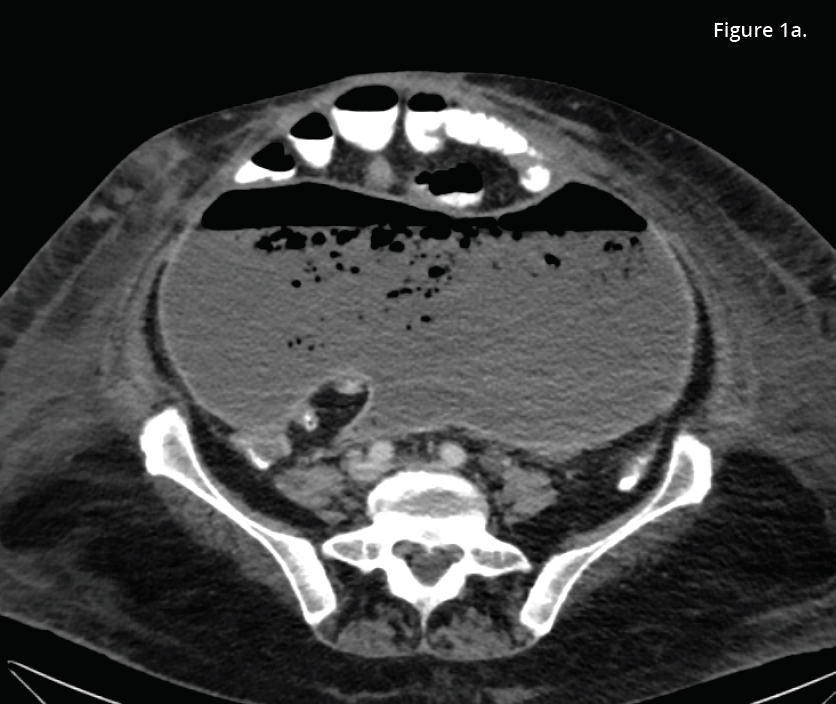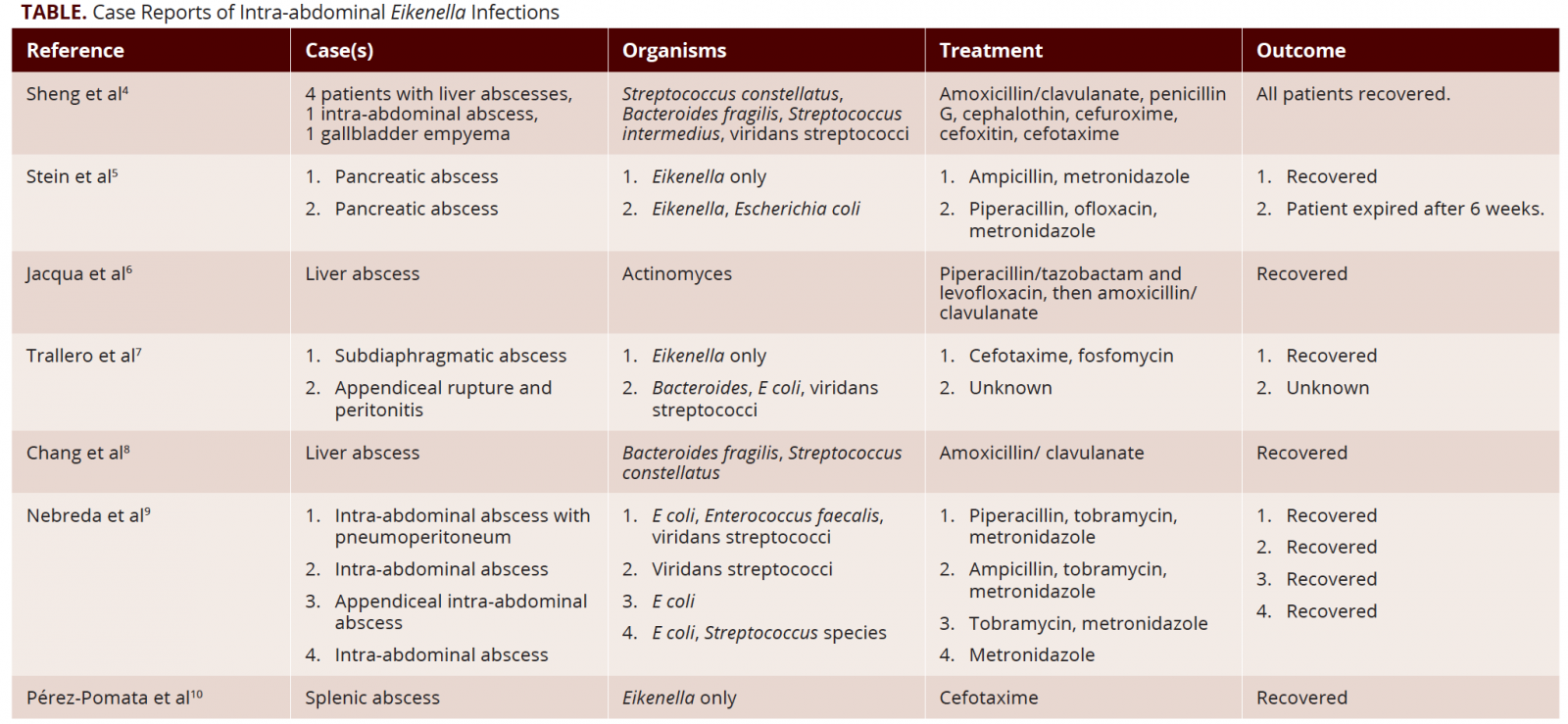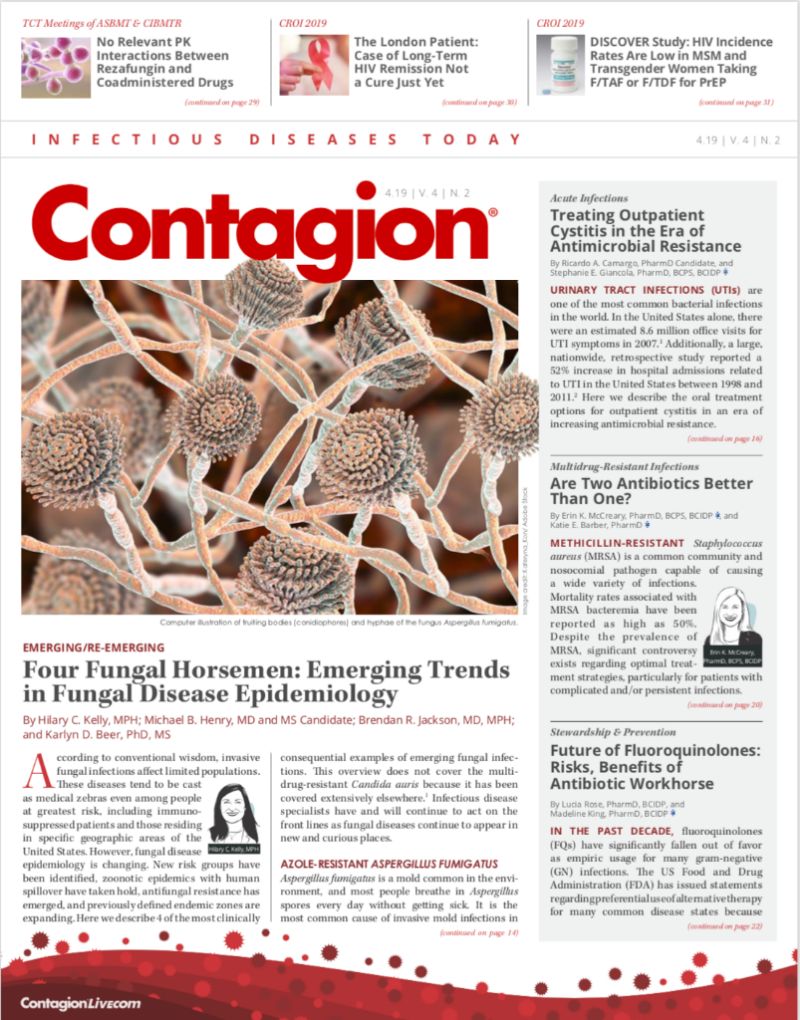Intra-abdominal Infection With Eikenella corrodens in a Woman With Ovarian Cancer
“A bite bug in the belly.”
HISTORY OF PRESENT ILLNESS:
A 63-year-old woman with stage IIIC ovarian cancer presented to clinic with confusion and hallucinations. A routine blood draw revealed severe anemia, and the patient was admitted for transfusion and observation. Nine months earlier, the patient had an upper abdominal hernia repair performed, complicated by a surgical wound infection with poor wound healing. She had several months of negative pressure wound therapy and underwent surgical debridement. Subsequently, she had a skin graft placed, with good wound healing. Two months after the skin graft was placed, the patient reported new abdominal pain, for which a computed tomography (CT) of the abdomen and pelvis was conducted, revealing a complex 7-cm adnexal mass. While awaiting surgery, the patient presented with worsening abdominal pain and distension. A repeat CT of the abdomen and pelvis revealed peritoneal nodules and ascites in addition to the adnexal mass. Paracentesis revealed malignant cells, and a biopsy of the adnexal mass was consistent with serous carcinoma of ovarian origin. The patient received her first round of carboplatin and paclitaxel shortly before presenting with her current complaint of altered mental status and anemia.
PHYSICAL EXAM:
On the patient’s admission, her vital signs were stable and she was afebrile. A physical exam was significant for a distended abdomen and multiple well-healed scars. Her dentition was good but notable for implants.
STUDIES:
Laboratory values revealed a white blood cell count (WBC) of 1.8 x 103/μL (normal, 4.5-11.0) and a hemoglobin of 5.5 g/dL (normal, 11.9-15.7). All other laboratory values were within normal limits. A CT of the abdomen and pelvis was revealing of interval organization of a large amount of free fluid throughout the peritoneal cavity with an enhancing wall (Figure 1a). The largest component of this collection measured 30 x 16 cm.DIAGNOSTIC PROCEDURES AND RESULTS:
A paracentesis was performed. Eight hundred milliliters of serosanguinous f luid was drained. Cell count revealed a WBC of 8100/μL with 81% polymorphonuclear leukocytes and Gram stain with gram-negative rods. Two days later, the culture grew small, gray colonies that pitted the agar, smelled like bleach, and were oxidase negative. The organism was identified as Eikenella corrodens. Kirby-Bauer disk diffusion tests demonstrated absent zone of clearance for clindamycin or metronidazole and a large zone for penicillins, fluoroquinolones, and cephalosporins.

TREATMENT:

The patient was treated with ampicillin/sulbactam 3 g every 6 hours for possible coinfection with anaerobic organism, with subsequent improvement in symptoms. Interval CT of the abdomen and pelvis revealed an organizing abscess with subsequent gas formation (Figure 1B), which was drained, and the culture grew both E corrodens as well as Bacteroides species. A transthoracic echocardiogram was revealing of moderate mitral regurgitation, but a subsequent transesophageal echocardiogram was negative for valvular vegetations.
DISCUSSION:
Eikenella corrodens is an organism commonly found in the mouth and upper respiratory tract, most often causing periodontitis, as well as skin and soft tissue infections in intravenous drug users who lick their needles before injecting.1 It has also been described in human bite wound infections.2 Traditionally E corrodens is described as one of the HACEK organisms, which cause culture-negative endocarditis.3 Our case describes an unusual instance of a woman with ovarian cancer complicated by an intraabdominal infection with E corrodens.
There are few case reports and series of intra-abdominal infections with Eikenella (Table). Sheng et al4 found 6 cases of intra-abdominal Eikenella, 4 of which were liver abscesses, out of a total of 43 cases. None of these cases were associated with ovarian cancer; however, associations were made with various other cancers, including oropharyngeal, lung, breast, neuroblastoma, and colon. In terms of treatment, Eikenella is sensitive to most β-lactam agents. There are no standardized clinical laboratory standards or institute guidelines for interpretation of Kirby-Bauer disk diffusion for E corrodens; however, it has been found in vitro to be resistant to clindamycin and metronidazole.11

Epstein is an assistant professor of medicine at Drexel University College of Medicine. She is also the medical director of Infection Control at Hahnemann University Hospital.Kleinberg is an associate professor of medicine and director of the Infectious Diseases Section of the Marlene and Stewart Greenebaum Comprehensive Cancer Center at the University of Maryland School of Medicine. He is also medical director of the Antimicrobial Stewardship program.Bork is an infectious disease specialist in Baltimore, Maryland. She received her medical degree from State University of New York Downstate Medical Center College of Medicine and completed her infectious disease fellowship at the University of Maryland.
References:
1. Burd EM, Steinberg, JP. Other gram-negative and gram-variable bacilli. In: Mandell GL, Bennett JE, Dolin R, eds. Mandell, Douglas, and Bennett’s Principles and Practice of Infectious Diseases. 7th ed. Philadelphia, PA: Churchill Livingstone Elsevier; 2010:3023-3024.
2. Merriam CV, Fernandez HT, Citron DM, Tyrrell KL, Warren YA, Goldstein EJ. Bacteriology of human bite wound infections. Anaerobe. 2003;9(2):83-86. doi: 10.1016/S1075-9964(03)00057-X.
3. Chambers ST, Murdoch D, Morris A, et al; International Collaboration on Endocarditis Prospective Cohort Study Investigators. HACEK infective endocarditis: characteristics and outcomes from a large, multi-national cohort. PLos One. 2013;8(5):e63181. doi: 10.1371/journal.pone.0063181.
4. Sheng WS, Hsueh PR, Hung CC, Teng LJ, Chen YC, Luh KT. Clinical features of patients with invasive Eikenella corrodens infections and microbiological characteristics of the causative isolates. Eur J Clin Microbiol Infect Dis. 2001;20(4):231-236.
5. Stein A, Teysseire N, Capobianco C, Bricot R, Raoult D. Eikenella corrodens, a rare cause of pancreatic abscess: two case reports and review. Clin Infect Dis. 1993;17(2):273-275.
6. Jaqua NT, Smith AJ, Shin TT, Jahanmir J. Actinocyces naeslundii and Eikenella corrodens as rare causes of liver abscesses. BMJ Case Rep. 2013;2013:bcr2013009613. doi: 10.1136/bcr-2013-009613.
7. Trallero EP, Garcia Arenzana JM, Cilla Eguiluz G, Tovar Larrucea J. Beta-lactamase-producing Eikenella corrodens in an intraabdominal abscess. J. Infect. Dis. 1986 Feb;153(2):379-380.
8. Chang PS, Ni YH, Lin WT, Lee CY, Chang MH. Isolation of Eikenella corrodens from polymicrobial hepatic abscess: report of one case. Acta Paediatr Taiwan. 1999;40(1):50-52.
9. Nebreda T, Merino FJ, Campos A. Five cases of extraoral infection associated with Eikenella corrodens. Eur J Clin Microbiol Infect Dis. 1997;16(3):254-256.
10. Pérez-Pomata MT, Domínguez J, Horcajo P, Santidrián F, Bisquert J. Spleen abscess caused by Eikenella corrodens. Eur J Clin Microbiol Infect Dis. 1992 Feb;11(2):162-163.
11. Merriam CV, Citron DM, Tyrrell KL, Warren YA, Goldstein EJ. In vitro activity of azithromycin and nine comparator agents against 296 strains of oral anaerobes and 31 strains of Eikenella corrodens. Int J Antimicrob Agents. 2006;28(3):244-248. doi: 10.1016/j.ijantimicag.2006.03.028.

